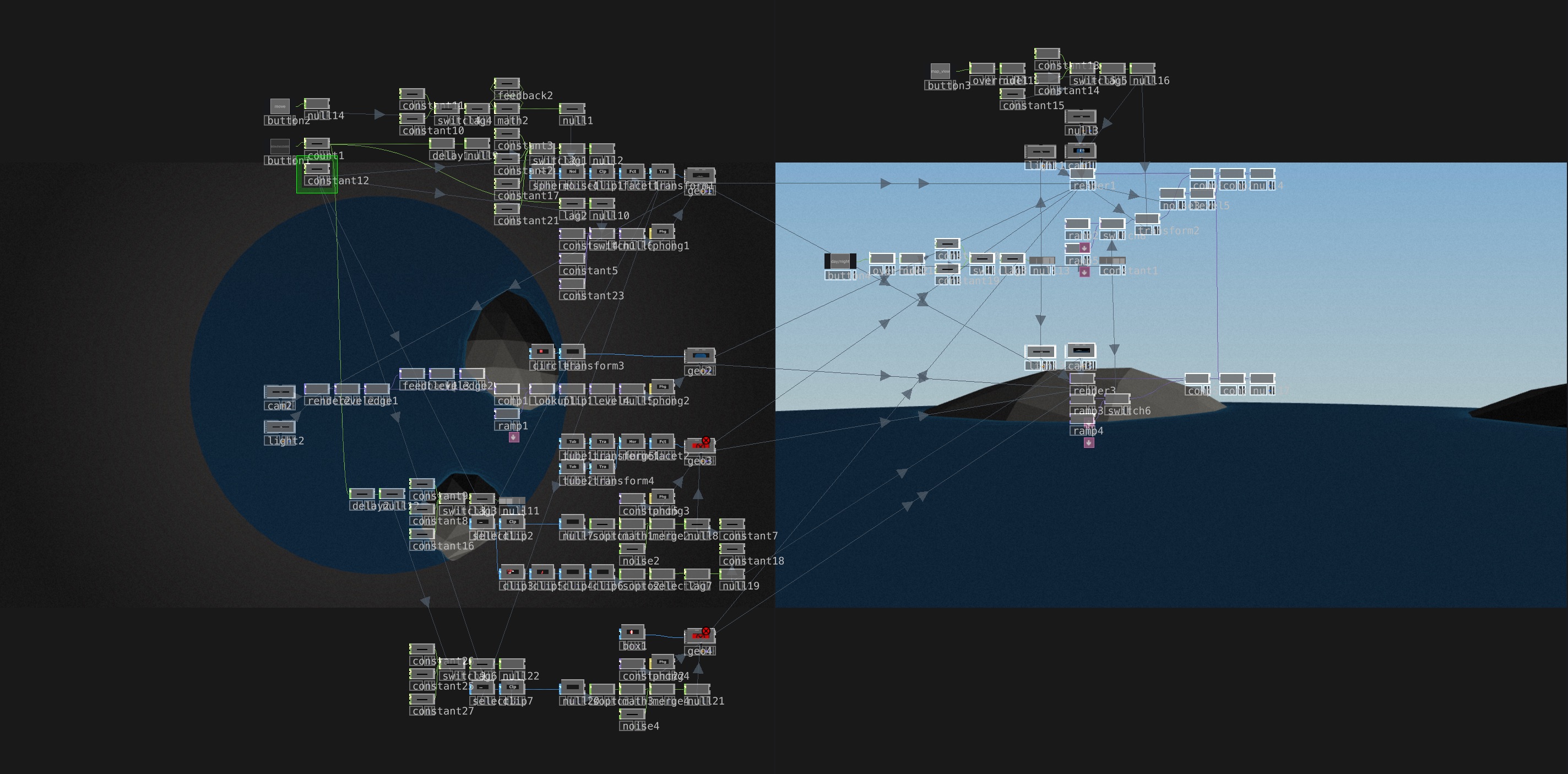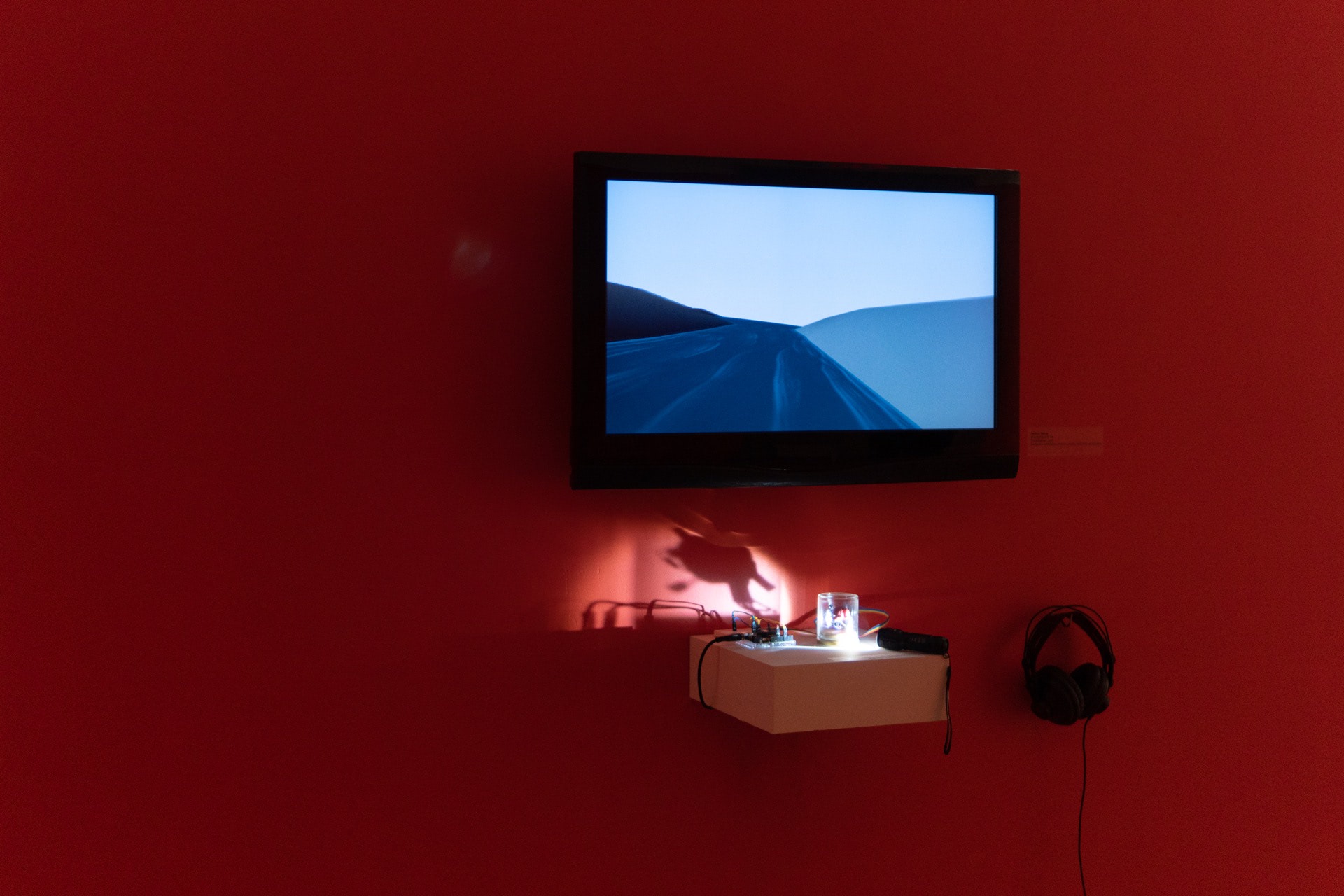Observer
(2022.5)Interactive Installation
Arduino, TouchDesigner, VCV Rack

The virtual world for us is the reality for this brain in the jar. As people observing the environment, they could also being ovserved by somone from a higher dimension. Observing a higher dimension is impossible, so as knowing the truth of this hypothesis. However, our thoughts are the proof of our existence, our lives give us agency and freedom, so we can find our own meanings that are not decided by anyone. That is to say, the brain in a jar can also decide its own meaning. We can create it, but we can never be a creator, only observers. 私たちに対してのバーチャル世界は、この⽔槽の中の脳にとっては真実。⼈が環境を観察する時、より⾼い次元の⽣命体に観察されるかもしれない。⾼次元は不可視だから、その答えは知る由もない。でも、私たちの思考は存在そのもの。存在⾃体が私たちに⼒と⾃由を与え、それによって、私たちは存在価値を⾒出すことができる。この⽔槽の脳もきっと、⾃分の意味と価値を決められる。そして私たちは創造主ではない、ただの創造者にして観察者なのだ。

Installation view at “Elsewhere, Within Here”
Pratt Institute, Brooklyn, August 1 – September 30, 2023
This is the final work of a series of research and a body of work focusing on the topic of Life, Meaning, and Existence.
The title “Observer” has multiple levels of meaning. The brain is observing the changing virtual world, and its perspective is controlled by the audience observing it. By bringing the sci-fi theory of the brain in a jar into a physical miniature, the audiences are subconsciously convinced that it is possible, and are provoked to think about if they are also being observed like that.
この作品は、生命、意味、存在 をテーマにした一連の研究の最終作品だ。
「Observer」というタイトルには、複数の意味がある。この脳は変化するバーチャル世界を観察しており、その視点はそれを観察している視聴者に制御されている。水槽の脳の SF 理論を現実のミニチュアに持ち込むことで、視聴者は無意識的にそれが可能であると信じ、自分もそのように観察されているかどうかを考えさせられる。

TouchDesigner network
The audience can use a miniature of a brain in a jar to control the perspective of a real-time generated virtual world in TouchDesigner. Rotating the physical object results in the same rotation of perspective on the screen. TouchDesigner also shares data with VCV Rack through OSC protocol, generating synchronized music that also won’t repeat. 視聴者は、水槽の中の脳のミニチュアを使用して、TouchDesigner でリアルタイムに生成されたバーチャル世界の視点を制御できる。 この装置を回転させると、画面上で視点が同じように回転する。また、TouchDesigner は、OSC を通して VCV Rack とデータを共有し、繰り返されない音楽を自動生成する。


different phases of the world / virtual synthesiser rack
The music has four patterns, corresponding with the four phases of the virtual world: the desert, forest and river, artificial buildings, the ocean, and loops back to the desert. The virtual world reflects on how humans damage the natural environment and how it recovers itself by destroying human civilizations. Much like a time-lapse of millions of years of the Earth’s history and future. バーチャル世界の 4 つのフェーズ (砂漠、森と川、人工建造物、海) に対応する音楽にも、4つのパターンがある。バーチャル世界は、人間が自然環境にどのようなダメージを与え、人間の文明を破壊することによって自然がどのように回復するかを表している。地球の何百万年もの歴史と未来のタイムラプスのようなものだ。
Installation view at “FARAWAY” solo exhibition
Dowel, Tokyo, January 14–15, 2023
An audio recording of the artist’s monologue is played from the headphone, explaining his understanding and feeling about storytelling. When he thinks of a story, the perspective always jumps between subjective and objective, while the emotions remain consistent. Two consciousness of one emerge, so he could be both the observer and the observed.
ヘッドフォンのみで再生されるアーティストの独り言は、彼のストーリーテーリングに対しての理解と感情を語る。物語を考えるとき、視点は常に主観と客観の間を飛び交うが、感情はそのままである。一人から2つの意識が生まれるので、彼は同時に観察者にも被観察者にもなれる。
Sometimes I see a piece of memory, a story, an illusion.
Who's the narrator? Who's the hero?
Are thee faraway or within myself?
Or the border between the two is in vague?

The audiences listen to the monologue and the music, observe the physical miniature of a brain in the jar, and discover the connection between the miniature and the virtual world on screen. They are provoked to think more about themselves, who are they observing, and whether they are also being observed. 視聴者は言葉と音楽の両方を聴き、水槽の脳のミニチュアを観察し、そのミニチュアと画面中の世界とのつながりを発見する。そして自分自身について、観察者と被観察者としての思考も一層深くなる。
FEATURED IN

Elsewhere, Within Here
Pratt Institute, NY
August 1 – September 30, 2023







